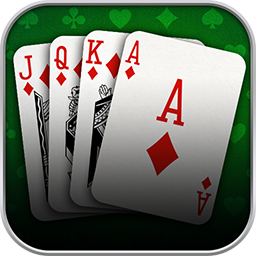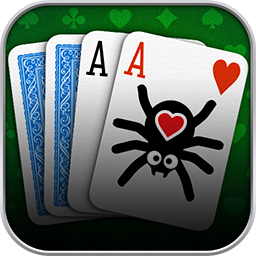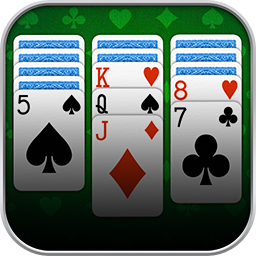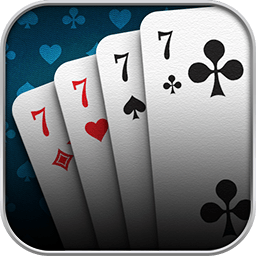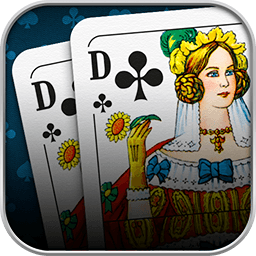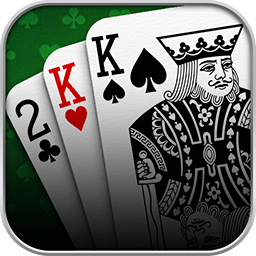Use this comprehensive A-to-Z guide to all essential Gin Rummy terminology and quickly find specific information or become an expert! To learn more about how the elements explained below interlock during gameplay, check the Gin Rummy Manual.
Ace:
In Gin Rummy, the Ace is worth only one point. It can only be placed at the beginning of a sequence, before a Two. However, with the custom rule Tedesco, an Ace can be worth 15 points, and the custom rule Cyclic Sequences allows Aces to follow Kings in a sequence.
Action:
During your turn, you can take multiple actions. First, you must draw a card, either from the draw pile or the discard pile. Then, you check if you can and want to knock. If you choose not to knock, you simply discard a card, and the next player takes their turn. Through custom rules, more options become available: catching the glass and boasting. You can find details in the respective glossary entry and on our page about the rule variants in Gin Rummy.
Boasting (Custom Rule):
You can boast in your turn if no other player already did so in this round. You cannot knock in the same turn, but you would receive bonus points for winning the round soon: If you knock and win in your first turn after you boasted, you gain 5 bonus points. You gain 10 bonus points in the second turn, and even 20 bonus points in the third turn. In case your opponent undercuts you after you knocked with boasting, nobody gets any boasting bonus points this round.
If your opponent knocks within the three turns after you announce boasting, you get no bonus points. If you don’t knock within three turns after you boasted, your opponent gains 15 bonus points, no matter which player knocks and wins.
To find out how boasting works in detail and how you can adapt your style of play to this new mechanic, take a look at our Boasting Lesson.
Bonus Points:
In Gin Rummy, the overall score is composed of multiple aspects, including points from deadwood and optional bonus points. These bonus points include the Box Bonus, Undercut Bonus, and Gin Bonus. The box bonus does not count towards your league score. Further bonus points can emerge due to the custom rules Catch the Glass and Boasting.
Box Bonus:
If you are playing at a table with a point limit of 50, this bonus does not apply. At a table with a higher point limit, this bonus comes into play, granting 10 points for winning a round. Like the Gin and Undercut bonuses in Gin Rummy, it always goes to the winning side.
Card Deck:
In Gin Rummy, one traditional set of playing cards is used: 52 cards from the American Poker pattern pack. The 13 ranks from Ace to King appear once in each of the four familiar suits Clubs, Spades, Hearts, and Diamonds.
Card Order:
In Gin Rummy, the cards always follow this ascending rank order: Ace, Two, Three, …, Ten, Jack, Queen, King. This is especially important for sequences. Only with the custom rule Cyclic Sequences can an Ace follow a King.
Card Value:
Each card rank has a point value in Gin Rummy. These card values are particularly relevant regarding deadwood: Ace – 1 point, Two to Ten – points corresponding to the card rank, Jack to King – 10 points.
Catch the Glass (Custom Rule):
You may try to catch the glass once per turn to gain bonus points: If you think that cards in the discard pile amount to a meld, you state whether it is a group or sequence, and then the card rank or suit, respectively. You cannot catch melds that are enabled only via other custom rules!
If you are right, the cards are removed from the discard pile, and you gain 10 bonus points at the end of the round. If you miss, your opponent gains 10 bonus points instead.
Use our lesson on Catch the Glass to learn how it works in detail in the Gin Rummy Game and how it could change your game strategy.
Custom Rules:
When creating a table in the Gin Rummy Palace, you can creatively customize the game. Choose from the rules Catching the Glass, Cyclic Sequences, Gin Pro, Boasting, Jokers, Oklahoma, Rainbow Sequences, Tedesco, and Training. You can find all details on our page about the Gin Rummy Variants.
Cyclic Sequences (Custom Rule):
When using this custom rule, you can now place the Ace after the King in sequences instead of exclusively before the Two. Additionally, the Ace can also be positioned between the Two and the King, allowing sequences to start with any card.
Deadwood:
This refers to the hand cards that do not belong to complete melds. To knock in Gin Rummy, the total card value of your deadwood cards must not exceed 10 points. If your opponent knocks first, you may still have the opportunity to lay off cards from your deadwood to their melds. If you knock and have no deadwood left after discarding, you have played Gin! Congratulations! Your opponent cannot undercut you, and you earn bonus points.
Deadwood Points:
This is the point value of your deadwood. Points from deadwood are always counted during the scoring at the end of the round. The player with the lower deadwood wins the round, and the difference between their deadwood points and the opponent’s deadwood points is credited to them.
Discard Pile:
At the beginning of a round, a card is revealed from the draw pile to serve as the base card for the discard pile. To start your turn, you can either draw a card from the draw pile or pick up a card from the discard pile. After all possible actions, your turn ends by discarding a card from your hand onto the open discard pile.
Draw Pile:
After shuffling and dealing the cards at the beginning of the round, the remaining cards are placed face-down in the middle of the table. This is the draw pile. You can draw from it when you start your turn. If the draw pile consists of only two cards and no one has knocked, the round automatically ends without a winner.
End of Round:
Typically, one of the two players ends the round. Specifically, you can initiate the end of the round by knocking. However, the round can also end if the draw pile contains only two cards and no one has knocked. In this case, there is no scoring, and there is no winner. But if the round ends regularly by knocking, the steps of revealing, laying off, and finally scoring follow.
Four-player mode:
Classic Gin Rummy is a two-player game. But at the Gin Rummy Palace, we want to enable you to play the game with four players in two teams in the future. This innovation will bring lots of fun and some exciting changes to the gameplay. You can find all the details on our page about Four-Player Gin Rummy!
Gin:
A Gin is a perfect game. Similar to going rummy in traditional Rummy, you receive a bonus if you manage to finish the game without any deadwood remaining.
Gin Bonus:
A gin bonus is only awarded to the winning side if they have also knocked. The condition for the gin bonus is that the winning side has 0 deadwood points. This is rewarded with 25 bonus points.
Gin Pro (Custom Rule):
Winning a table becomes slightly more challenging: Not only do you have to reach a specific score, but you also need to win a minimum number of rounds. If you meet both conditions at the end of a round, you win, and the table ends automatically. If both players meet both conditions at the same time, the player with the higher score wins.
Gin Rummy:
The classic card game can entertain two people with fast and intense gameplay. You collect melds in your hand until a player announces the end of the round. This is followed by scoring and possibly the next round.
Group:
This is a type of valid melds in Gin Rummy. A group consists of three or four cards of the same rank, for example, the Seven of Hearts, the Seven of Clubs, and the Seven of Spades.
Hand Cards:
After shuffling at the beginning of the round, each player receives 10 cards. The remaining cards are set aside as the draw pile. With each turn, you can exchange a card and collect melds in your hand until a player, maybe you, announces the end of the round by knocking. Only then are the hand cards laid off.
Jokers (Custom Rule):
Three Jokers are added to the deck. You can use them instead of any other card in melds. To double your opponent’s deadwood points, discard a Joker when knocking. A Joker in the deadwood counts 15 points. If you knock and meld a Joker, your opponent may place the fitting card from their deadwood onto the Joker. With that, this card doesn’t add to their deadwood anymore.
Knocking:
If you want to end playing for this round, you can knock after drawing a card. This involves discarding one final card. After discarding, your deadwood must be worth at most 10 points. However, you are never forced to knock, regardless of how low your deadwood is.
Laying Off:
If you reveal deadwood after knocking, your actions for the round are over, and you cannot lay off your deadwood cards to melds later. However, after revealing all hand cards, your opponent can lay off their deadwood cards onto your melds. The added cards no longer count as part of their deadwood. They cannot use your deadwood cards or detach any cards from your melds.
Meld:
Combinations of at least three cards in Gin Rummy are called melds. We distinguish two types: groups (cards of the same rank) and sequences (consecutive cards of the same suit). With the custom rules Cyclic Sequences and Rainbow Sequences, more options become available.
Oklahoma Gin (Custom Rule):
This custom rule affects the deadwood threshold for knocking. After dealing, the bottom card of the draw pile is revealed and remains face up beneath it, rotated 90 degrees for the entire round. In this round, the deadwood threshold for knocking is set to the value of the face-up card.
Only for an Ace, instead of its card value, the threshold for deadwood is reduced to 0 points, requiring a Gin to knock.
You can get a detailed look at the Oklahoma changes, their effects, and strategy adjustments in our lesson on Oklahoma Gin.
Playing Card Pattern:
In Gin Rummy you traditionally play with 13 ranks in four suits, totaling 52 cards. Gin Rummy is primarily played with the poker deck in French suits, including Aces, number cards from Two to Ten, Jacks, Queens, and Kings. The suits of Gin Rummy cards are Clubs, Spades, Hearts, and Diamonds.
Rainbow Sequences (Custom Rule):
With this custom rule, in addition to classic sequences, rainbow sequences can be melded. A rainbow sequence consists of exactly four cards with consecutive ranks, each having a different suit. Red cannot follow red, and black cannot follow black. For example, a valid rainbow sequence would be Ace of Hearts, Two of Spades, Three of Diamonds, Four of Clubs.
Rank:
Together with the suit, the rank defines each playing card. In Gin Rummy, the ranks are Ace, the numbers Two to Ten, Jack, Queen, and King. Each of these ranks appears once per suit.
Reveal:
If you knock, you must first discard one of your hand cards as the last card onto the discard pile. Then, you put your hand cards face-up on the table, sorting them into melds and deadwood if you have any, and you announce the deadwood points if necessary. Now, your opponent also reveals their cards.
Round:
Usually, a table of Gin Rummy consists of multiple rounds. A round starts with dealing the cards and ends with scoring points after one of the players knocks. The points from each round are accumulated to determine the overall score of the table.
Run:
See sequence.
Scoring:
In Gin Rummy, the total score of a round is always composed of several aspects: points from deadwood and optional bonus points. You can find all the details on our Gin Rummy Scoring Page.
Sequence:
This is a type of valid melds in Gin Rummy. A sequence consists of at least three cards with consecutive ranks, for example, the Nine of Hearts, the Ten of Hearts, and the Jack of Hearts. Cards in the same sequence must have the same suit. An Ace can only be at the beginning of a sequence, and a King can only be at the end. The custom rules Cyclic Sequences and Rainbow Sequences add optional exceptions to these rules.
Set:
See Group.
Suit:
The suit, together with the rank, defines each playing card. In Gin Rummy, the usual suits are Clubs, Spades, Hearts, and Diamonds. Each rank appears once per suit.
Table:
At the Gin Rummy Palace, you play at tables. The number of players, point limit, bet, and other conditions are determined before the game starts. A game at the table ends when one player reaches the required number of points. After the last round, the total score of each player is determined, and you return to the lobby. If there is a premium player among you, you may play another table with the same players under the same conditions.
Tedesco (Custom Rule):
This custom rule makes Aces more dangerous. If Tedesco is in effect at the table and you knock, Aces in your opponents’ hands count for 15 points instead of one point! If you draw a card from the discard pile, you can only knock in that turn if the drawn card belongs to one of your valid melds. Typically, Tedesco is combined with the custom rule Cyclic Sequences.
Check out our Tedesco Gin Lesson for an even more detailed look at the Tedesco changes, their effects, and strategy adjustments.
Training (Custom Rule):
This table does not affect the league or your skill ranking. But you still gain experience points.
Turn:
It’s your turn after the previous player discarded a card. You can now pick up that card or take a card from the draw pile. Then, you see if this card allows you to make new melds or extend existing melds. If you don’t knock, you end your turn by discarding one of your own cards, and the next player can start their turn. Custom rules may add additional available actions between drawing and discarding.
Undercut:
If an opponent knocks but you have equal or fewer deadwood points, then you achieved an undercut. Congratulations! You won the round and, in addition to the difference in your deadwood points and the box bonus, you also earn a hefty undercut bonus of 20 points! Your opponent gets nothing.
Undercut Bonus:
This bonus only applies if the knocking side does not win. So, if your opponents have knocked but you have equal or fewer deadwood points, you have achieved an undercut. For that, you receive 20 bonus points.

